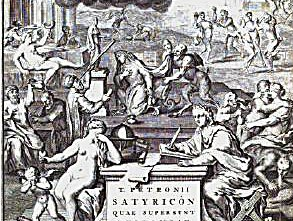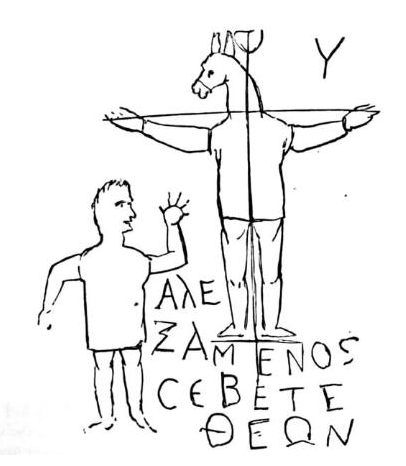Realistic fork
by hinz from paulys
we try to do it that way
Fork carrier, furcifer, becomes a nickname for the slave (Plaut. Most. 69. 1172). The slave is led around with the (dung) fork, shown to the audience, especially the neighbors. It is especially important that he is shown to his fellow slaves. So it is with all who disobeyed the commandments of the LORD. At the same time, of course, the slave still needed to be reminded that he absolutely had to offer non-violent resistance. so:
no violence
The most important virtue of a slave. Because in Rome, violence by slaves against free slaves was punishable by death, ie crucifixion. The slave and his fellow slaves should definitely be reminded of this
The furcifer was thus led around and beaten with rods at the same time; a procedure that has a parallel in the Prussian military: the steaming. When whipping, the soldiers had to form a lane. Each soldier had to hit them with rods, whips or sticks. The foisting was also included other armies, but the Prussian was notorious. Angela Merkel, FDJ member, also follows this tradition. In the GDR, young FDJ members were brought up to be subservient. In my opinion, Angela Merkel's chancellorship proves that this upbringing worked. How is the spirit of servility generated in Roman slaves and in Prussia. through congestion.
Excursus:
For this purpose, the slaves were made to put on an S furca and with rods (virga) or sticks, Latin palus, = post, wood Vulgar Latin palo or Swabian-Wandal Vulgar Latin pfalo or stake. Latin gets really vulgar when it evolves and becomes Spanish and then becomes falo, phallus. that you put a slave in the buttocks of a female slave. Because then there are anal shepherd's hours when a good shepherd does what the shepherd boy does. Catch his lost sheep to sell them at the end.
end of excursion
The procedure can be compared to the display in the pillory; the public, fellow slaves, and neighbors, and henceforth beware of this slave: ὅπως ἀπιστοῖεν αὐτῷ καὶ φυλάττοιντο πρὸς τὸ λοιπόν (Plut. 70 quaest.). In addition to insults, the furca means torture for the slave, the intensity of which depends on the type of execution; with the furca the (sub furca) virgis caedere is always mentioned; ( Virgis Rute, possibly a rhetorical stylistic device. virgo = rod, virga = virgin ) with the furca is always the (sub furca) virgis caedere. The caedere is taken care of by slaves (ἕτεροι οἰκέται Plut. Cor. 24); the master certainly had the theoretical right to have the slave whipped to death sub furca. It may also have happened in practice. (Not proven. But in no case is caedere sub furca always and necessarily execution of a death penalty.
As a rule, it is only a preparation for the death penalty, which itself is carried out in another form (e.g. crucifixion), cf. the general sub virgis caedere in Livius (II 26) with the more precise report of Plutarch (Cor. 24. 25), who says twice in describing the same case: ἐξήλασαν μαστιγοῦντες, εἶτ' ἐθανάτωσαν. It is by no means proven that the sub furca caedere was the normal form of slave execution.
The furca and the sub furca virgis caedere are therefore applied to slaves. Sometimes also applied to free persons; in Suetonius (Nero 49) it is explained to Nero when asked that the supplicium more maiorum recognized by the senate against him consists in the inseri furcae, caedi virgis ad necem, and in Aurelius. Vict. ep. 5, the Senate expressly imposes this penalty with reference to the mos maiorum. Recently, Mommsen also considered the virgis caedere to be the oldest 'magistrate form of execution of the free citizen' and identified it with the punishment of crucifixion. This view is untenable. First of all, the pontifical execution of the vestal virgin's paramour must be ruled out; here it comes to virgis ad necem caedere (Liv. XXII 57. Suet. Dom. 8. Dionys. Hal. ant. VIII 89. IX 40) and according to one testimony (Dion in Zonar. VII 8. above) also used the f., but that is a very singular execution (like the vestal virgin herself being buried alive) and does not belong in the area of public criminal law, but in the area of domestic breeding (Mommsen: the vestal virgin is a house daughter of the community). Leaving aside this special case, all other reports showing the application of the f. to free persons refer to cases of perduellio (state crimes): Liv. I 26. Cic. per Rab. 15th Liv. ep. 55. Suet. nope 49 (hostem se iudicatum). Aurelius. Vict. ep. 5. Precisely here, however, an application of a procedure that otherwise only occurs with slaves [307] is not conspicuous because, according to the Roman idea, the perduellis already resigns from the citizens' association through his act and joins the circle of enemies of the country (Mommsen criminal law 590), the Use of the f. shows that the exit has already taken place. Incidentally, in these cases the virgis sub furca caedere, contrary to the assurances of Nero's advisors, is probably not the capital punishment itself, but only the preparation for the capital punishment (execution or enslavement, on the latter Liv. ep. 55). Specifically about the typical Horatian process, see Art. Crux.
Finally, the f. is frequently mentioned as a death penalty in the Digests; it has been used here by Justinian's compilers instead of the crux spoken of by the classical jurists. The change is related to the abolition of the penalty of the cross; the f. punishment of the later imperial period (replacement of crucifixion) is now a death penalty, execution by hanging on a gallows, which has the shape of the fork standing upright (tines pointing upwards) (Pauly-Wissowa VII,1, 0307a.jpg) ; instead of the tollere in crucem, the εἰς φούρκαν ἀναρτᾶν now appears, see Harmenope. man. Leg. VI 6, 25. VI 8, 2, and above Art. Crux.
Literature. s.d. Lit. to Art. Crux and also Marquardt Privatleben der Römer I 181ff. Pernice Ztschr. Savigny Foundation XVII 215. Mommsen Rom. Penal Code 918ff. Hot Switzerland. Ztschr. f. criminal law XIII 223ff. Art. crux (Saglio) and f. (Blanchet) in Daremberg et Saglio's Dictionnaire des antiq. grecq. et rom. (with several illustrations). new text













